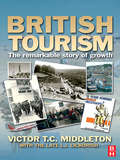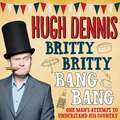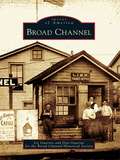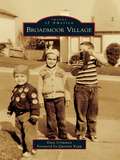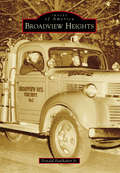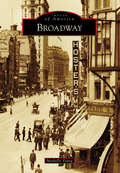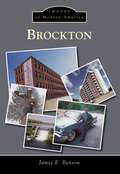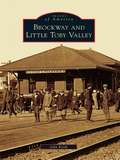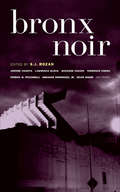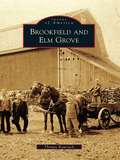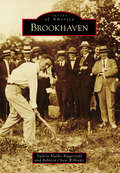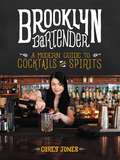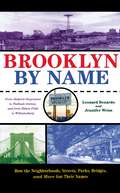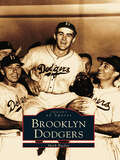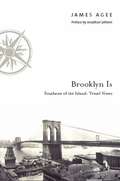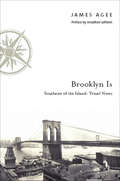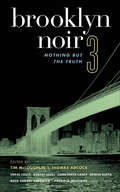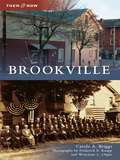- Table View
- List View
British Rail
by Christian WolmarThe authoritative and fascinating history of the rise and fall of the state-owned British Rail'Wolmar's book is impeccably organised and makes a fast, enjoyable read' THE TIMES Literary Supplement________British Rail wasn't how we're asked to remember it . . .From ancient rolling stock to patchy service, stale sandwiches to the wrong kind of snow, British Rail - our last great state-owned organisation to be privatised - has received a terrible press.But after its controversial 1948 creation, British Rail was actually an innovative powerhouse that over five decades transformed the UK, creating one of the fastest regular rail services in the world.Award-winning journalist Christian Wolmar takes us from promise to punchline, exploring British Rail's birth into post-war austerity, the many battles and struggles to evolve what many considered to be a dinosaur, and how, at the height of its success, the service was misunderstood and unfairly maligned, ruthlessly broken up and privatised._______Praise for Christian Wolmar'Wolmar is the high priest of railway studies' Literary Review'The greatest expert on British trains' Guardian'Our most eminent transport journalist' Spectator'If the world's railways have a laureate, it is surely Christian Wolmar' Boston Globe 'Christian Wolmar is in love with the railways. He writes constantly and passionately about them. He is their wisest, most detailed historian and a constant prophet of their rebirth . . . if you love the hum of the wheels and of history, then Christian Wolmar is your man' Observer
British School at Rome Studies: Turin and the British in the Age of the Grand Tour (British School at Rome Studies)
by Paola Bianchi Karin WolfeThe Duchy of Savoy first claimed royal status in the seventeenth century, but only in 1713 was Victor Amadeus II, Duke of Savoy (1666-1732), crowned King of Sicily. The events of the Peace of Utrecht (1713) sanctioned the decades-long project, the Duchy had pursued through the convoluted maze of political relationships between foreign powers. Of these, the British Kingdom was one of their most assiduous advocates, because of complimentary dynastic, political, cultural and commercial interests. A notable stream of British diplomats and visitors to the Sabaudian capital engaged in an extraordinary and reciprocal exchange with the Turinese during this fertile period. The flow of travellers, a number of whom were British emissaries and envoys posted to the court, coincided, in part, with the itineraries of the international Grand Tour which transformed the capital into a gateway to Italy, resulting in a conflagration of cultural cosmopolitanism in early modern Europe.
British Tourism: The Remarkable Story Of Growth
by Leonard J Lickorish Victor T.C. MiddletonTourism at any point in time is in many ways a mirror of economic and social change. The changes in British society in the decades from the 1950s to the 21st century are reflected in the forms of tourism that the British have been able to aspire to and afford. 'British Tourism: A Remarkable Story of Growth' identifies the most significant of these changes and places them in an historical context highlighting four distinctive eras. Now in paperback it includes four colour photos as well as two brand new chapters on tourism in Scotland and Wales.It looks in detail at the following key areas: * The roots of post war tourism growth * Developments in transport and regulation * Developments in accommodation and visit attractions * Marketing developments and trends - the role of entrepreneurs * Tourism trends into the 21st centuryOffering a comprehensive evaluation of post war developemnts in the British tourism industry, British Tourism: The remarkable story of growth, acts as a single reference resource suitable for a wide ranging readership from students on tourism courses and practitioners in the travel and tourism industries
Britons Through Negro Spectacles (Black Britain: Writing Back #10)
by ABC Merriman-Labor'We shall therefore confine our walk to Central London where people meet on business during the day, and to West London where they meet for pleasure at night. If you will walk about the first City in the British Empire arm in arm with Merriman-Labor, you are sure to see Britons in merriment and at labour, by night and by day, in West and Central London.'In Britons Through Negro Spectacles Merriman-Labor takes us on a joyous, intoxicating tour of London at the turn of the 20th century.Slyly subverting the colonial gaze usually placed on Africa, he introduces us to the citizens, culture and customs of Britain with a mischievous glint in his eye.This incredible work of social commentary feels a century ahead of its time, and provides unique insights into the intersection between empire, race and community at this important moment in history.Selected by Booker Prize-winning author Bernardine Evaristo, this series rediscovers and celebrates pioneering books depicting black Britain that remap the nation.
Britty Britty Bang Bang: One Man's Attempt to Understand His Country
by Hugh DennisHugh Dennis' hilarious and insightful exploration of the changing image of Britain and Britishness will enthral those who love Outnumbered, The Now Show, Mock the Week and quintessentially British humour. 'Utterly readable and laugh-out-loud funny' - Stephen Fry Hugh Dennis has secretly been worrying about what being "British" meant for nearly a decade, ever since his friend Ardal O'Hanlon had told him in passing that he was the most British person he had ever met. Hugh was unclear whether he was being praised, teased, vaguely insulted or possibly all three - because it has always been very difficult to know how to feel about being British.In 2012 we surprised the world. Not only did we provide an Olympic Games much better than Mitt Romney expected, or the French hoped, we also presented a completely new face - a gleaming fresh vision of Britain. Who thought that the country we knew so well would suddenly nip up into the national loft and bring down so much we had all forgotten about? What are our great traditions?Are we really good at inventing stuff? Are we obsessed by the weather?Did we invent Democracy?Who was Kenneth Branagh meant to be in that opening ceremony?Frankly this country has got some explaining to do... What readers are saying about Britty Britty Bang Bang:'Pure Hugh Dennis! Witty Britty! A witty anecdote in every other sentence''An amusing yet also enlightening trawl through British history and cultural values''Hugh Dennis writes very much in character - highly amusing and observant'
Britty Britty Bang Bang: One Man's Attempt to Understand His Country
by Hugh DennisHugh Dennis' hilarious and insightful exploration of the changing image of Britain and Britishness will enthral those who love Outnumbered, The Now Show, Mock the Week and quintessentially British humour. 'Utterly readable and laugh-out-loud funny' - Stephen Fry Hugh Dennis has secretly been worrying about what being "British" meant for nearly a decade, ever since his friend Ardal O'Hanlon had told him in passing that he was the most British person he had ever met. Hugh was unclear whether he was being praised, teased, vaguely insulted or possibly all three - because it has always been very difficult to know how to feel about being British.In 2012 we surprised the world. Not only did we provide an Olympic Games much better than Mitt Romney expected, or the French hoped, we also presented a completely new face - a gleaming fresh vision of Britain. Who thought that the country we knew so well would suddenly nip up into the national loft and bring down so much we had all forgotten about? What are our great traditions?Are we really good at inventing stuff? Are we obsessed by the weather?Did we invent Democracy?Who was Kenneth Branagh meant to be in that opening ceremony?Frankly this country has got some explaining to do... What readers are saying about Britty Britty Bang Bang:'Pure Hugh Dennis! Witty Britty! A witty anecdote in every other sentence''An amusing yet also enlightening trawl through British history and cultural values''Hugh Dennis writes very much in character - highly amusing and observant'
Broad Channel (Images of America)
by Dan Guarino Liz Guarino Broad Channel Historical SocietyBroad Channel is considered a small town in the big city. From its houses perched on stilts over the waters of Jamaica Bay to pairs of mute swans swimming across the waters of a popular beach of yesteryear, it is hard to believe Broad Channel lies within the boundaries of New York City. The only inhabited island in Jamaica Bay, it arose from the area known as Big Egg Marsh on navigational charts. It began as a fishermen's haven and grew into a summer vacation playground with fine hotels. During Prohibition, with bootleg liquor easily smuggled by boat, the isolated island became known as a rumrunner's paradise and became home to several speakeasies. Through vintage images, Broad Channel explores the area's boardwalks and unpaved roads to celebrate the community's rich history.
Broadmoor Village (Images of America)
by Dave CrimmenBroadmoor Village, the little community that embodies the American ethic of independence, survives despite neighboring annexations, budget crises, and even Mother Nature. This subdivision was built in San Mateo County by the Stoneson Company just after World War II, targeting returning veterans and their families. Established before Henry Doelger made neighboring Westlake, Westmoor, St. Francis, and other communities since annexed by Daly City, Broadmoor has repeatedly chosen to stay unincorporated and independent. This attitude has shaped Broadmoor through the years to assert its autonomous stature while surrounded by larger cities.
Broadview Heights (Images of America)
by Donald Faulhaber Jr.Located in southern Cuyahoga County at the crossroads of the Ohio Turnpike and Interstate 77 are the rolling hills and forested landscapes of Broadview Heights. "Highest of the Heights" is the phrase coined by disc jockey Ed Fisher when radio station WGAR's broadcast studio was located in Broadview Heights. Many radio personalities either lived here or in neighboring communities, and events in Broadview Heights were often mentioned on the radio. Part of the Cleveland Metro Parks surrounds the southern edge of town, including the highest point in Cuyahoga County. Among those who call Broadview Heights home are Radio Hall of Fame disc jockey Candy Lee, artist Shirley Aley Campbell, figure skater Tonia Kwiatkowski, and Cultural Olympiad gold medal-winning ice sculptor Aaron Costic of Elegant Ice Creations.
Broadway
by Michelle YoungFrom its origins as a Native American trail to its iconic status in global culture today, Broadway tells the story of New York as it grew from a Dutch colony into a world-class city. Broadway has been the site of many firsts and many superlatives: the first subway line in the city, the tallest buildings, and one of the longest streets in the world. Beginning along the winding streets of the original settlements amid the skyscrapers of the Financial District, Broadway heads north through the neighborhoods of SoHo and Greenwich Village. It then traverses some of the city's most famous plazas, including Flatiron, Herald Square, Times Square, and Columbus Circle, before entering Upper Manhattan and passing institutions like Lincoln Center, Columbia University, and City College. Today, Broadway continues to be at the forefront of New York City's urban developments.
Brockton: The 1941 Brockton Tragedy And The Fallen Thirteen (Images of Modern America)
by James E. BensonBrockton, first settled in 1700, was originally a part of Old Bridgewater, known as North Parish and later as North Bridgewater. On April 9, 1881, it officially became the City of Brockton. During the Civil War, Brockton was the largest producer of shoes in the country, earning it the nickname "Shoe City." As a growing industrial center, Brockton had the proud honor of being first in the world and nation in many ways. On October 1, 1883, the city became the first in the world to have a three-wire underground electrical system, initially turned on by Thomas Edison. In 1884, the Central Fire Station became the first electrically operated fire station in the country. In 1894, the City Theater had the distinction of being the first in the world tied to a three-wire underground system. In 1890, Col. James Edgar, owner of Edgar's Department Store, donned a Santa Claus outfit, becoming the first department store likeness of the jolly old man. Brockton is also known as the "City of Champions," being the hometown of boxing greats Rocky Marciano and Marvelous Marvin Hagler.
Brockway and Little Toby Valley
by John KeithBrockway, originally called Brockwayville until the name was shortened in 1925, is named after the Brockway family pioneers who settled near the southern bend of Little Toby Creek in 1822. The Brockways were followed by several other settlers, including the "Father of Brockway," Dr. Asaph M. Clarke, who laid out the town in 1836. Farming and lumbering were the original industries, but by 1883, coal mining had brought in the railroads. Railroads introduced more industry, the most famous being the Brockwayville Machine Bottle Company in 1907. Through images from the Brockway Area Historical Society, Brockway and Little Toby Valley chronicles the development of this industrious community.
Broken Earth: The Rural Chinese
by Steven W. MosherPutting aside the esoteric and the academic, postponing the process of statistical analysis and sociological generalization, I found that there remained a tale of what it is like to live in today's China, told by the rural Chinese themselves. In retelling their anecdotes and observations, I have sought to bring the rural Chinese within reach, to describe what it is like to live with them in their villages and celebrate the lunar New Year with jian dui pastries and lion dances, to mourn with them at funerals and rejoice with them at marriages and the birth of sons, to sit with them at collective meetings and listen to them discuss crops and policy, to take tea with them in their tea houses at dawn and to enjoy a game of basketball with them at dusk, coming over time to appreciate the bitterness of their past, the frustrations of their present, and their hopes for the future.
Bronx Noir (Akashic Noir)
by S. J. RozanBrand-new stories by: Thomas Adcock, Kevin Baker, Thomas Bentil, Lawrence Block, Jerome Charyn, Suzanne Chazin, Terrence Cheng, Ed Dee, Joanne Dobson, Robert Hughes, Marlon James, Sandra Kitt, Rita Laken, Miles Marshall Lewis, Pat Picciarelli, Abraham Rodriguez Jr., S.J. Rozan, Steven Torres, and Joe Wallace. S.J. Rozan was born and raised in the Bronx and is a lifelong New Yorker. She's the author of eight novels in the Lydia Chin/Bill Smith series, and of the stand-alones Absent Friends and In This Rain (forthcoming). Her books have won Edgar, Nero, Macavity, and Shamus awards for best novel. She's at work on another series novel, Shanghai Moon.
Brookfield and Elm Grove
by Tom RamstackThe old town of Brookfield provides an ethnic microcosm of what makes Wisconsin's settlement story so unique. As Native Americans, primarily the Potawatomi tribe, were forced out of the region, in came large numbers of Protestant farmers from New York State. A step and a half behind the New Yorkers came distinct colonies of families from western Europe--Catholics from near Nuremberg, Bavaria; Evangelical Lutherans from Canton Bern, Switzerland; Methodists from Lincolnshire, England; Zion Evangelicals from Sulzback, Württemberg; as well as Catholics from County Sligo, Ireland.
Brookhaven (Images of America)
by Valerie Mathis Biggerstaff Rebecca Chase WilliamsBrookhaven has long benefited from its prime location. With two creeks running through it and the well-traveled thoroughfare that became Peachtree Road, Brookhaven was a familiar place to Native Americans, Civil War soldiers, and early settlers like the Goodwin family, whose home became a railroad stop. Adjacent to the city of Atlanta, Brookhaven grew into a community of gracious neighborhoods, parks, and lakes and became home to Oglethorpe University. In 2013, Brookhaven became a city, and it continues to benefit and grow as businesses and families are attracted by its proximity to Atlanta.
Brooklyn Bartender: A Modern Guide to Cocktails and Spirits
by Carey JonesA first-of-its-kind collection, The Brooklyn Bartender gathers 300 of the most innovative, exciting, and authentic cocktail recipes from this booming, destination borough at the height of its international popularity. Brooklyn is one of the top trendsetting places today anywhere. Its neighborhoods, artists, writers, restaurants, and, yes, drinking establishments set the pace for the rest of the nation. Brooklyn Bartender takes us behind the bar to experience 300 of the best and most inventive drinks being served today, plus tips for at-home mixologists. Organized by spirit, the recipes allow readers to replicate bartenders' signature drinks, including everything from the ornate juleps and cobblers of Maison Premiere to the party-friendly "Frozemonade" at Extra Fancy to the namesake gin cocktail of Clover Club. Additional features include "5 Takes on the Martini" and variations on other classic drinks, as well as bartenders' recommendation for events, infused spirits, and more. Designed to be the perfect bar-side companion, the sophisticated compilation will be enhanced by more than 250 photos and illustrations.
Brooklyn By Name: How the Neighborhoods, Streets, Parks, Bridges, and More Got Their Names
by Leonard Benardo Jennifer WeissHow the places in Brooklyn got their names--complete with vivid photographs and maps From Bedford-Stuyvesant to Williamsburg, Brooklyn's historic names are emblems of American culture and history. Uncovering the remarkable stories behind the landmarks, Brooklyn By Name takes readers on a stroll through the streets and places of this thriving metropolis to reveal the borough’s textured past.Listing more than 500 of Brooklyn’s most prominent place names, organized alphabetically by region, and richly illustrated with photographs and current maps the book captures the diverse threads of American history. We learn about the Canarsie Indians, the region's first settlers, whose language survives in daily traffic reports about the Gowanus Expressway. The arrival of the Dutch West India Company in 1620 brought the first wave of European names, from Boswijck (“town in the woods,” later Bushwick) to Bedford-Stuyvesant, after the controversial administrator of the Dutch colony, to numerous places named after prominent Dutch families like the Bergens.The English takeover of the area in 1664 led to the Anglicization of Dutch names, (vlackebos, meaning “wooded plain,” became Flatbush) and the introduction of distinctively English names (Kensington, Brighton Beach). A century later the American Revolution swept away most Tory monikers, replacing them with signers of the Declaration of Independence and international figures who supported the revolution such as Lafayette (France), De Kalb (Germany), and Kosciuszko (Poland). We learn too of the dark corners of Brooklyn“s past, encountering over 70 streets named for prominent slaveholders like Lefferts and Lott but none for its most famous abolitionist, Walt Whitman.From the earliest settlements to recent commemorations such as Malcolm X Boulevard, Brooklyn By Name tells the tales of the poets, philosophers, baseball heroes, diplomats, warriors, and saints who have left their imprint on this polyethnic borough that was once almost disastrously renamed “New York East.”Ideal for all Brooklynites, newcomers, and visitors, this book includes:*Over 500 entries explaining the colorful history of Brooklyn's most prominent place names *Over 100 vivid photographs of Brooklyn past and present*9 easy to follow and up-to-date maps of the neighborhoods *Informative sidebars covering topics like Ebbets Field, Lindsay Triangle, and the Verrazano-Narrows Bridge*Covers all neighborhoods, easily find the street you're on
Brooklyn Dodgers (Images of Sports)
by Mark RuckerIf there was ever a place in America where a city and its baseball team were as close as family, it was Brooklyn. The legacy of this relationship comes down to us in stories of childhoods spent at Ebbets Field and in the stories of Jackie Robinson and Branch Rickey, whose courage changed the face of America. Baseball in Brooklyn goes back to the beginning of the sport, when a young city embraced a new game and, like missionaries, carried it to the nation. This book tells the story of that beginning and concludes with the heart-wrenching move of the franchise to the West Coast after the 1957 season. Brooklyn Dodgers carries us from the birth of baseball in the streets of Brooklyn through the decades in Flatbush when Ebbets Field was the center of the Brooklyn community. That was a time when the players lived in the neighborhoods not far from the ballpark, side by side with their followers. Duke Snider, Pee Wee Reese, Jackie Robinson, Gil Hodges, and Johnny Podres all make appearances in this exciting selection of photographs. A large part of Brooklyn Dodgers is dedicated to those teams of the 1950s and their irrepressible fans.
Brooklyn Dodgers in Cuba (Images of Baseball)
by Jim VittiThe Brooklyn Dodgers held spring training in Havana in 1947 so Jackie Robinson could practice safely. <P><P>Yet that was hardly the beginning: the Bums played in Cuba over 60 seasons, from 1900 to 1959. Ballplayers drank hard with Hemingway. Some found themselves in Cuban jails. Pitcher Van Lingle Mungo, barricaded in the Hotel Nacional with two women, fended off an angry husband (and his machete). Leo Durocher got into a brawl with an umpire, after Lippy's translator correctly cursed him in Spanish. Vin Scully watched machine gun-toting barbudas enter the room. An outfielder leaped into the stands, with a loaded gun, to chase a fan. <P><P>Several players encountered Castro, who once walked onto the field in his fatigues, patted his pistol, and said to Lefty Locklin, "Tonight, we win."
Brooklyn Is -- Southeast of the Island: Travel Notes
by James Agee Jonathan LethemIn 1939, James Agee was working for Fortune magazine. Commissioned to write an article on Brooklyn for a special issue on New York, Agee moved to the Flatbush neighborhood for two months, later producing "Southeast of the Island: Travel Notes". As had earlier happened with the essay that was to become his classic portrait of southern farmers, "Let Us Now Praise Famous Men", Fortune declined to publish, and the essay remained unpublished until its 1968 Esquire appearance under the title "Brooklyn Is". In the words of Brooklyn-born novelist Jonathan Lethem, who provides the introduction to the essay in this volume, "the narrative rises up on the swirling imaged-junked cone of Agee's prophetic style to see the borough and its people whole".
Brooklyn Is: Travel Notes
by James Agee Jonathan LethemFor the first time in book form—a great writer’s classic celebration of the essence of Brooklyn. In 1939, James Agee was assigned to write an article on Brooklyn for a special issue of Fortune on New York City. The draft was rejected for “creative differences,” and remained unpublished until it appeared in Esquire in 1968 under the title “Southeast of the Island: Travel Notes.” Crossing the borough from the brownstone heights over the Brooklyn Bridge out through backstreet neighborhoods like Flatbush, Midwood, and Sheepshead Bay that roll silently to the sea, Agee captured in 10,000 remarkable words, the essence of a place and its people. Propulsive, lyrical, jazzy, and tender, its pitch-perfect descriptions endure even as Brooklyn changes; Agee’s essay is a New York classic. Resonant with the rhythms of Hart Crane, Walt Whitman, and Thomas Wolfe, it takes its place alongside Alfred Kazin’s A Walker in the City as a great writer’s love-song to Brooklyn and alongside E. B. White’s Here Is New York as an essential statement of the place so many call home. James Agee was born in Knoxville, Tennessee, in 1909. One of the great prose stylists of the past century, Agee wrote in many forms—poetry, short stories, novels, essays, commentary, and criticism. In 1958 he won the Pulitzer Prize for fiction for A Death in the Family, and he also wrote the classic account of poor Southern farmers, Let Us Now Praise Famous Men, accompanied by Walker Evans’s documentary photographs. With John Huston, he wrote the Oscar-nominated screenplay for The African Queen, and he was an influential film and theater critic for Time and The Nation. James Agee died in 1955 of a heart attack in a New York City taxicab. In the fall of 2005, the Library of America will publish a two-volume collection of his writings. Jonathan Lethem’s novels include Fortress of Solitude and Motherless Brooklyn, which won the National Book Critics Circle Award, his most recent book is The Disappointment Artist. Lethem was born and raised in Brooklyn, where he still lives.
Brooklyn Noir 3: Nothing But the Truth (Akashic Noir #3)
by Tim Mcloughlin Thomas AdcockAkashic Books continues its award-winning series of original noir anthologies, launched in 2004 with Brooklyn Noir. This volume presents the first nonfiction collection in the series, curated by acclaimed novelists Tim McLoughlin and Thomas Adcock.Brand-new stories by: Robert Leuci, Dennis Hawkins, Tim McLoughlin, Thomas Adcock, Errol Louis, Denise Buffa, Patricia Mulcahy, C.J. Sullivan, Reed Farrel Coleman, Aileen Gallagher, Christopher Musella, Kim Sykes, Robert Knightly, Jess Korman, Constance Casey, and Rosemarie Yu."There is a difference, as editor, between cheering the literary accomplishment of a fiction writer who has delivered a brilliant story about a serial killer or hit man, and reading the true account, however beautifully written, of a young woman raped, murdered, and forgotten. So this book, though it has its light moments (and thank God for those), is for me the darkest of the Brooklyn Noir series. These pieces remind us that crime is personal. It happens to us and to our neighbors. Sometimes it happens because we do nothing to prevent it. Life does not always offer the moral arc we so desperately crave in fiction. If it did, we'd have no need for myths and fables, religion or miracles . . ."Read this book. Enjoy it. Be horrified by it. Carry it with you always. And the next time you're watching a particularly bizarre and salacious news item on the television set in your neighborhood pub, and the guy on the next stool says, "You can't make this shit up," smack him with it."--Tim McLoughlin, from the introduction
Brooklyn: The Once and Future City
by Thomas CampanellaAn unprecedented history of Brooklyn, told through its places, buildings, and the people who made them, from the early seventeenth century to todayAmerica's most storied urban underdog, Brooklyn has become an internationally recognized brand in recent decades—celebrated and scorned as one of the hippest destinations in the world. In Brooklyn: The Once and Future City, Thomas J. Campanella unearths long-lost threads of the urban past, telling the rich history of the rise, fall, and reinvention of one of the world’s most resurgent cities.Spanning centuries and neighborhoods, Brooklyn-born Campanella recounts the creation of places familiar and long forgotten, both built and never realized, bringing to life the individuals whose dreams, visions, rackets, and schemes forged the city we know today. He takes us through Brooklyn’s history as homeland of the Leni Lenape and its transformation by Dutch colonists into a dense slaveholding region. We learn about English émigré Deborah Moody, whose town of Gravesend was the first founded by a woman in America. We see how wanderlusting Yale dropout Frederick Law Olmsted used Prospect Park to anchor an open space system that was to reach back to Manhattan. And we witness Brooklyn’s emergence as a playland of racetracks and amusement parks celebrated around the world.Campanella also describes Brooklyn’s outsized failures, from Samuel Friede’s bid to erect the world’s tallest building to the long struggle to make Jamaica Bay the world’s largest deepwater seaport, and the star-crossed urban renewal, public housing, and highway projects that battered the borough in the postwar era. Campanella reveals how this immigrant Promised Land drew millions, fell victim to its own social anxieties, and yet proved resilient enough to reawaken as a multicultural powerhouse and global symbol of urban vitality.
Brookville
by Wrayanne L. Clapie Carole A. Briggs Frederick E. KnappBrookville photographer Frederick E. Knapp documented the events, people, and places of Brookville, the seat of Jefferson County, between 1898 and 1945. Teacher and amateur photographer Wrayanne L. Clapie revisited those sites in 2008. Now a federally registered historic district, Brookville's Main Street buildings, businesses and industries, schools, churches, and homes typify architecture during the last part of the 19th century and life during the first half of the 20th century, illustrating both change and preservation.


